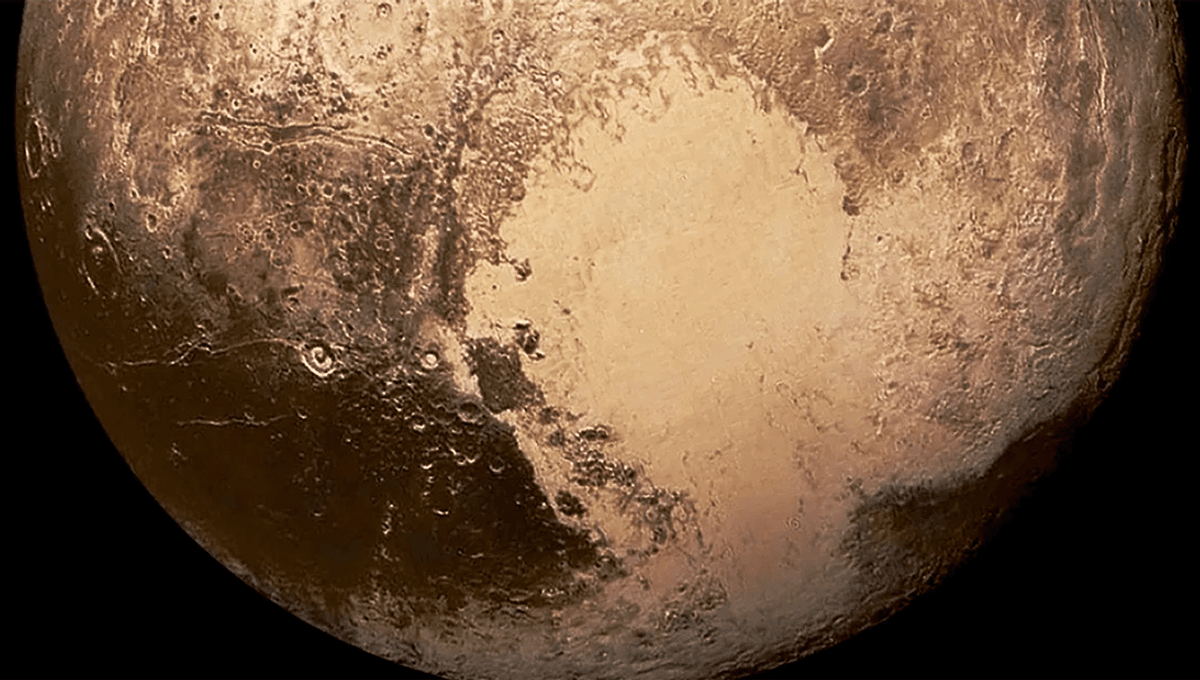
When NASA’s New Horizons spacecraft flew past Pluto and its moons in July 2015, it sent back the first close-up photos we have of the dwarf planet. With it, it brought a mystery, one that has finally been solved.
Photographs revealed an unusual heart-shaped structure on Pluto’s surface, known as Tombaugh Regio, or “Pluto’s heart”, the western part of which covers around the same area as a quarter of the USA. The structure has puzzled astronomers ever since, primarily due to the highly reflective white surface and its unclear origin.
“The bright appearance of Sputnik Planitia is due to it being predominantly filled with white nitrogen ice that moves and convects to constantly smooth out the surface,” Dr Harry Ballantyne from the University of Bern, lead author of a new study, explained in a statement. “This nitrogen most likely accumulated quickly after the impact due to the lower altitude.”
In the study, astrophysicists from the University of Bern and members of the National Center of Competence in Research (NCCR) PlanetS ran simulations to explain what caused such a feature.
It had previously been suggested that the feature is the result of an impact, given similar structures seen on other worlds, reshaped by tidal and rotational forces. However, this model only worked if there was a positive gravity anomaly, or more gravity than we would expect from looking at the mass in the area.
Areas of higher and lower gravity occur on Earth, and are caused by nearby structures of higher or lower mass (say from a mountain range or a subducted tectonic plate). When we can’t explain the gravity of an area by looking at local topography, this is called a gravity anomaly. As dramatic as this sounds, all it really means is that we haven’t located the missing mass (or lack thereof) explaining the gravity we see, yet.
In the case of Pluto’s heart, it was suggested that it could be caused by an ancient impact if the gravity in the region was higher than it appears. The difference in what we expect and what we are seeing could be explained by a subsurface ocean, providing a positive gravity anomaly, according to one team.
However, in the new paper, researchers found that their models could explain the structure of the heart without the need for a subsurface ocean.
“In our simulations, all of Pluto’s primordial mantle is excavated by the impact, and as the impactor’s core material splats onto Pluto’s core, it creates a local mass excess that can explain the migration toward the equator without a subsurface ocean, or at most a very thin one,” Dr Martin Jutzi of the University of Bern explained, adding that “the elongated shape of Sputnik Planitia strongly suggests that the impact was not a direct head-on collision but rather an oblique one.”
Using Smoothed Particle Hydrodynamics (SPH) simulation software, the team varied the angle, speed, and size of impact, as well as altering the composition of Pluto. The team found that the model fit best when Pluto was impacted by an ice-rock object around 730 kilometers (450 miles) wide at low velocity.
“Pluto’s core is so cold that the rocks remained very hard and did not melt despite the heat of the impact, and thanks to the angle of impact and the low velocity, the core of the impactor did not sink into Pluto’s core, but remained intact as a splat on it,” Ballantyne added.
Just like Earth, which likely contains ancient planet Theia, Pluto’s smaller impactor probably remains.
“Somewhere beneath Sputnik is the remnant core of another massive body,” co-author Professor Erik Asphaug from the University of Arizona added, “that Pluto never quite digested.”
The study is published in Nature Astronomy.
Source Link: Tombaugh Regio: Simulations Explain Pluto's Mysterious Heart And Gravity Anomaly